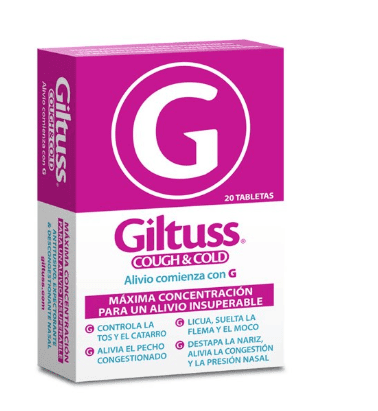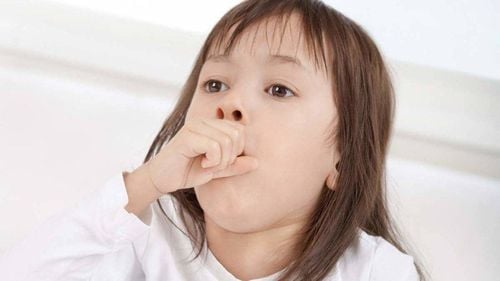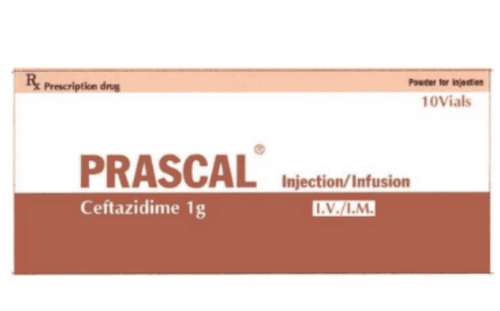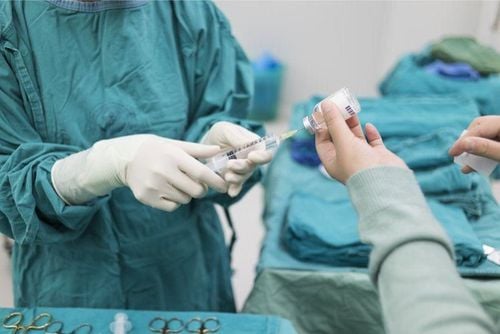This is an automatically translated article.
Posted by Doctor Nguyen Thi Tam - Pediatric Center - Vinmec Times City International General Hospital
Bronchiolitis is an acute infectious disease of the small and terminal bronchioles called bronchioles. This condition blocks the bronchioles. When the bronchioles are inflamed, swollen, edematous, they secrete a lot of mucus, making the airways narrow, causing difficulty breathing, even obstruction due to mucus leading to atelectasis.
1. Pathogens of bronchiolitis
The most common cause of bronchiolitis in children are viruses, led by respiratory syncytial virus (RSV) accounting for 50-80% of cases, capable of causing epidemics due to respiratory syncytial virus (RSV). : RSV can live 30 minutes on human skin, 6-7 hours on objects or clothing, several days in large droplets of secretions from the nose or mouth of the patient and in the air. Can be caused by influenza and parainfluenza virus, Adenovirus, Rhinno virus,...
The disease usually appears in winter, early spring.
Routes of transmission :
The most common way of transmission is through droplets of saliva, large secretions from the nose, mouth, and in the air. Spread from child to child through hands of caregivers and by surface contact. infected (toys, sick children's clothes).

Viêm tiêu phế quản lây truyền qua đường giọt bắn từ người mang bệnh
Risk factors:
The child is in an outbreak of influenza or RSV upper respiratory tract infection. Children who have been sick due to previous viral infections (rhinitis, tonsillitis, VA, etc.) Childhood < 3 months Premature babies, children who are not fully breastfed Passive smoking Congenital heart disease with pulmonary hypertension Congenital lung disease, cystic fibrosis, bronchopulmonary dysplasia, etc. Immunodeficiency, malnutrition.
2. Signs to detect children with bronchiolitis
Bronchiolitis is common in children < 2 years old, especially 3 to 6 months old. Children with symptoms of upper respiratory tract infection 2-3 days before: Mild fever, cough, runny nose. After 3-5 days: cough is worse with wheezing, may have difficulty breathing, rapid breathing, chest constriction. In severe cases, breast feeding may be stopped, cyanosis... Symptoms of the whole body may be high fever, irritability, and lethargy. Most sick children recover on their own in about 10 days, and the cough subsides and goes away. Some children may have a persistent cough.
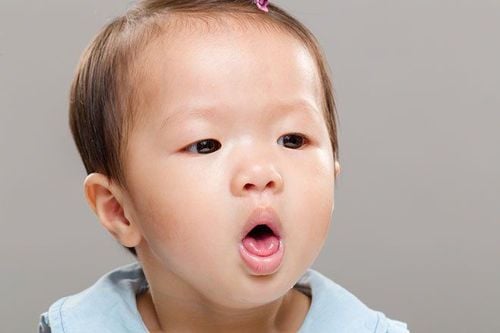
Trẻ bị sốt và ho trong thời gian đầu mắc bệnh
3. Signs that need to be hospitalized when a child has severe bronchiolitis
Some children are at high risk of serious illness: premature babies, low birth weight, children < 3 months, children with congenital diseases, children with immunodeficiency, children who are not breastfed, children living in crowded environments casting, narrow, low socio-economic conditions.
Severely ill children need to be hospitalized when:
There are signs: poor feeding, cyanosis, inability to drink, lethargy, difficulty awakening, shortness of breath, rapid breathing, chest constriction. There are high risk factors. There are complications: respiratory failure, pneumonia, atelectasis, otitis media.
4. Caring for children with bronchiolitis at home:
Children with bronchiolitis without complications, no risk factors can be cared for at home:
Breastfeed, eat well, eat less to avoid vomiting, drink lots of water to thin sputum Clear the nose with physiological saline drops to make it easier for the baby to breathe and suckle Take medicine exactly as prescribed by the doctor. Do not arbitrarily use drugs because it can be harmful to children if used incorrectly. Avoid smoke and tobacco. Secondhand smoke can make a child sicker and more likely to develop asthma later in life. It is necessary to detect signs of aggravation so that the child can go to a medical facility for medical examination.
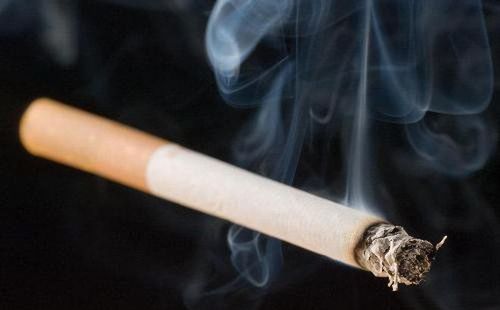
Không cho trẻ tiếp xúc với khói thuốc để tránh mắc các bệnh về hô hấp sau này
5. Treatment of bronchiolitis at the hospital:
Anti-respiratory failure:
Rehydration with electrolytes, prevention and treatment of dehydration Symptomatic treatment Treatment of cause General methods: There is no specific treatment, treatment is mainly supportive against respiratory failure. Breathing:
Clearing the airways: the chamber is cool, the child's head is about 30 degrees high, and the sputum is sucked. Oxygen therapy: oxygen is humidified, the purpose of oxygen is to maintain SpO2 > 95%, the child's cyanosis and shortness of breath are gone. Replenish water and electrolytes: drink a lot of water (Oresol can be given) to compensate for the loss of water and electrolytes due to high fever, rapid breathing, vomiting, poor appetite. If necessary, intravenous fluids can be given. Intubation, artificial ventilation if there is severe respiratory failure, apnea, acidosis. Medicines:
Do not routinely use bronchodilators, corticosteroids, expectorants. It can be tried and depending on the response of each child, decide to continue or stop using it. Antibiotics are only used in case of superinfection Respiratory physiotherapy:
Resolve nasopharyngeal obstruction Passive and slow exhalation technique and cause coughing
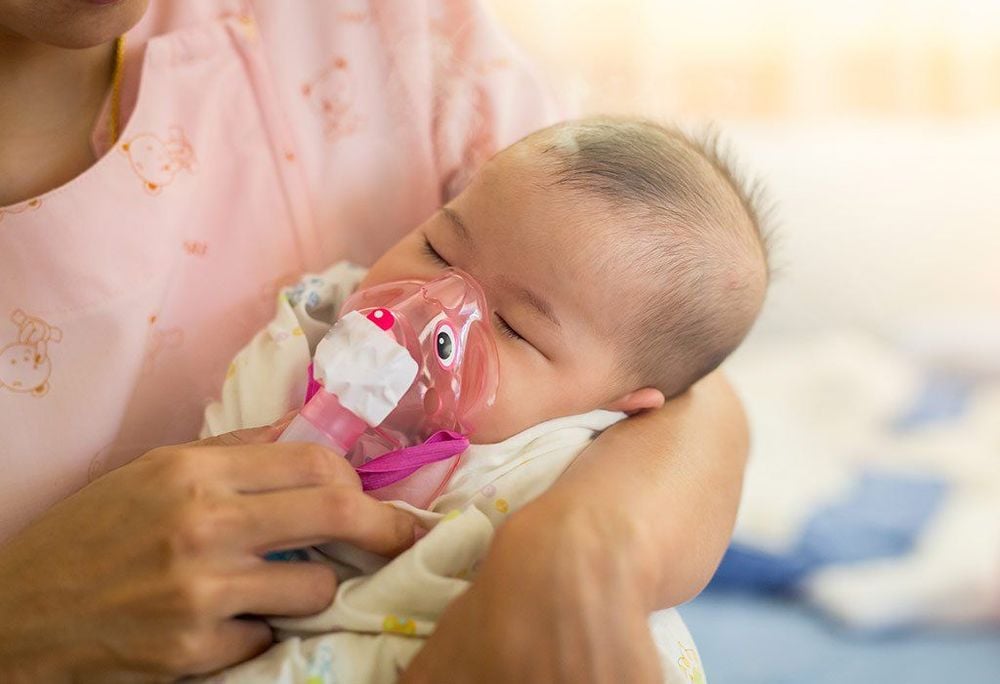
Điều trị viêm tiêu phế quản ở bệnh viện bằng những biện pháp hỗ trợ chống suy hô hấp
6. Caring for children with bronchiolitis
Make the patient lie in the correct position: Head elevated Respiratory physiotherapy: No routine appointment required. Indicated mainly when the patient has complications of atelectasis. Aspirate sputum, open airways Give thin, divided meals Vibration, postural drainage Monitor pulse, temperature, respiratory rate and oxygen saturation
7. Prevention for children:
Wash hands with soap and water before touching children Avoid contact with people who are coughing, cold or have fever, especially during the RSV epidemic season, avoid crowded places Do not share toys with sick children Keep keep children warm when the weather changes or change seasons Avoid smoke, dust and polluted environment Feeding children properly and breast-feeding Fully vaccinated to increase children's resistance To register for examination and treatment At Vinmec International General Hospital, you can contact the nationwide Vinmec Health System Hotline, or register online HERE.





